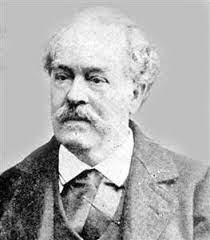
ANDRÉS POEY AGUIRRE
Andrés Poey Aguirre was an outstanding geographer and meteorologist, considered a precursor in Cuba of research in that field, although he also dedicated a great part of his scientific activity to Zoology, Geography and Ethnology. He was born on November 15, 1825 in Havana and was the son of the notable Cuban naturalist Felipe Poey. As a geographer he elaborated in 1848 an Atlas with 28 lithographed maps for primary schools, which was the first of its kind printed in Cuba. Its objective was to complement, with its practical use, the theoretical classes that his father offered in that same subject.
In 1853 he inserted the study Cuban Antiquities in the third volume of the works of the American Ethnological Society. It was a brief description of some relics found in the Cuban territory. It included the analysis and illustration of the "Idol of Bayamo", important piece of the Indo-Cuban archaeology, discovered by the Spaniard Miguel Rodriguez Ferrer in his investigations of 1847.
To develop his atmospheric investigations, around 1850 Aguirre created an observatory on the roof of his house in Havana with his own means and resources, but did not succeed due to lack of official support, the organization of a network of stations that would provide meteorological services throughout the island.
In addition to meteorology, Andres Poey Aguirre conducted research in the fields of zoology, geography and anthropology. A student of hurricanes, he worked on the statistics of these environmental phenomena and in 1855 he elaborated a catalog on these organisms under the title of Chronological Table that includes 400 hurricanes and cyclones that have occurred in the West Indies and the North Atlantic from 1493 to 1855. He achieved great specialization in studies on clouds, and in those related to the passage of comets and shooting stars.
He collaborated in the field of Agricultural Meteorology with the Smithsonian Institute, of Washington, and with the Department of Agriculture of the United States. Andres Poey was also Director of the Physical-Meteorological Observatory of Havana, a project made official by the Spanish colonial government in 1856; but years later he was dismissed by the Spanish authorities themselves.
He was also interested in the application of electricity to medicine. He ventured into therapeutic procedures by founding in Havana, during the 1850s, an electrochemical bathhouse. He was a member of several scientific corporations of his time, among them, the Royal Academy of Sciences of Paris, the Ethnological Society of London and the Royal Academy of Medical, Physical and Natural Sciences of Havana. Andres Poey died in Paris, France, on January 4, 1919.
Albert Gallatin and John Russell Bartlett founded the American Ethnological Society (AES) in New York in 1842. Its aim was to promote research in ethnology and all research relating to human beings. The first meetings of the AES were held in members' homes, where they discussed all aspects of human life, from history and geography to philology and anthropology. The AES was an academic institution, where papers were presented and then published.
Royal Academy of Sciences of Paris
This academy, dedicated to the development of science and energy advice in this area, was created in 1666, during the reign of Louis XIV under the patronage of his prime minister Jean-Baptiste Colbert and initially counting scientists such as René Descartes, Blaise Pascal and Pierre de Fermat. It is one of the five French academies hosted by the Institut de France.